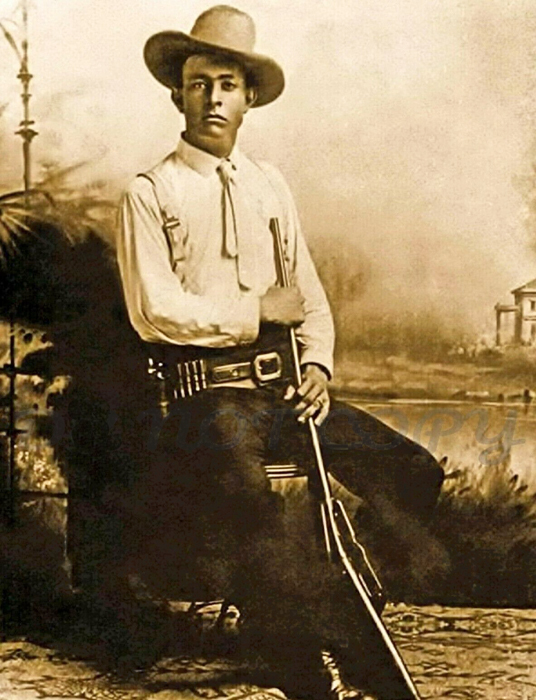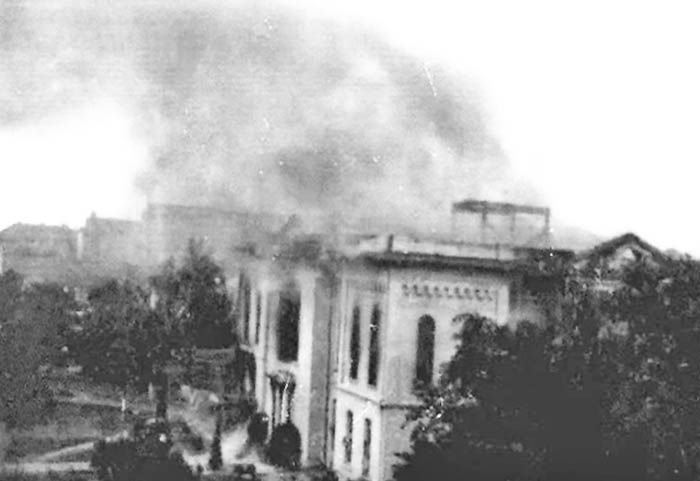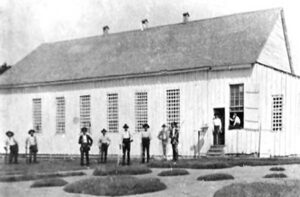Captain Frank Hamer was a Texas Ranger and Lawman who led the posse that tracked down and killed notorious outlaws Bonnie Parker and Clyde Barrow in 1934. Throughout his years of service, he was known for his courage, toughness, marksmanship, and investigative skills.
Francis Augustus Hamer (pronounced Hay-mer) was born in Fairview, Texas, on March 17, 1884, to Franklin Augustus and Lou Emma Francis Hamer. One of six children, he grew up on the Welch Ranch in San Saba County. The family moved to Oxford, Texas, in 1894, where Hamer worked as a calf wrangler in his father’s blacksmith shop. He was interested in history and studied Texas Rangers and Native Indian tribes.
Hamer killed his first man in 1900 when he was only 16. He and his brother Harrison, four years his junior, worked with rancher Dan McSwain. Aware of Frank’s ability with a weapon, McSwain asked the youngster if he wanted to make an extra $150. Thinking McSwain was joking, Frank replied, “Who do I have to kill?”
McSwain was having trouble with a rancher and wanted Frank to “solve” the problem. Frank quickly realized that his landlord was deadly serious and told McSwain he was only “kidding” and had no intention of killing anyone. McSwain responded, “If you let one word of this out, I’ll kill you!”
Frank and Harrison were plowing a field two days later when McSwain approached them. He told Harrison to go into the nearby barn to get some equipment, but before he reached the barn, he heard a noise, and turning, he saw McSwain approaching his brother with a shotgun. Yelling to Frank, “Look out!” Frank jumped to the side, and McSwain’s blast barely missed him. As Frank began to run for cover, McSwain shot again, with the buckshot hitting Frank in the back and head, knocking him to the ground. Frank then drew a small pistol and returned fire, hitting McSwain, who fell to the ground.
Neither shot was fatal, and Harrison rushed to his brother’s side, and the two hid in a nearby draw. In the meantime, McSwain went to his house, and carrying an old buffalo gun, he began searching for the brothers without success.
It took Frank some time to heal, and he carried some buckshot in his back until he died. After recuperating, Hamer returned to the farm and confronted McSwain on June 12, 1900. McSwain was shocked, stating that he thought he had murdered the boy, when Frank replied, “Not by a damned sight. I’ve come to settle accounts.” With that, the pair went for their guns, and McSwain fell to the ground, dead.
In 1901, Frank and Harrison moved to Sheffield, Texas. They had been hired as wranglers on the Pecos Ranch of Barry Ketchum. Barry was the brother of the notorious outlaw Tom “Black Jack” Ketchum. The Hamer brothers were still working on the ranch on April 26, 1901, when Black Jack was hanged in Clayton, New Mexico.
By 1905, Frank worked as a cowboy on the Carr Ranch between Sheffield and Fort Stockton. He volunteered his services to the local sheriff, Dud Barker, to apprehend a horse thief. Sheriff Barker was so impressed by the successful effort that he recommended Frank to the Texas Adjutant General, saying that Frank would make an excellent Texas Ranger.
On April 21, 1906, 22-year-old Frank Hamer became the newest Texas Ranger. He was assigned to Captain John H. Rogers of Company C in Alpine, Texas. Captain Rogers ordered Hamer to report to Sergeant Jim Moore in Sheffield to patrol the border in south Texas. Hamer soon found himself in the Del Rio area. Until 1908, he rode the border, upholding the laws of Texas. Frank’s older brother Estelle and younger brothers Harrison and Flavus also became Rangers.
At 24, he resigned to become the City Marshal in Navasota, Texas, an oil boomtown 70 miles from Houston overrun with violence and crime. Shootouts on the main street were so frequent that during two years, at least 100 people were killed. Lawmen did not typically last long there because they were either intimidated or bought off. Hamer, however, tamed the town.
He served in this position until April 1911, when he became a special investigator for Mayor Horace Baldwin Rice, working out of the Harris County sheriff’s office. Frank worked in Harris County for the next four years, helping maintain law and order in that rough and woolly part of Texas. In 1914, he was hired as a deputy sheriff in Kimble County and assigned as the department’s livestock theft investigator.
In 1915, Frank returned to the Texas Rangers and was stationed along the Rio Grande border. The situation along the Mexican border had not improved during his absence; instead, it was worse than ever. He was assigned to patrol the South Texas border during the Bandit War and La Matanza, a period of anti-Mexican violence in Texas. Between 1910 and 1920, the violence, including lynchings and massacres, occurred amid tensions between the United States and Mexico during the Mexican Revolution. From Big Bend to Brownsville, the Rangers dealt with arms smugglers, bootleggers during the Prohibition era, and bandits throughout the area.
He left the Rangers and was commissioned as a Special Ranger for the Texas and Southwestern Cattle Raisers Association.
At 33, Frank married a widow, Gladys Johnson Sims, on May 12, 1917. She had two daughters; the couple would have two sons, Frank Jr. and Billy. Gladys and her brother Sidney Arthur Johnson had been charged in 1916 with murdering her late husband, Ed Sims of Snyder, Texas. Though they were accused, they were never convicted. On a family trip, the Hamers were stopped in Sweetwater on October 1, 1917, to buy gas. Suddenly, Gus McMeans, a former Texas Ranger and a relative of the slain ex-husband, ambushed them. Frank was wounded, but he shot McMeans through the heart. Ten shots were fired in the gunfight, and police collected seven revolvers, two semi-automatic pistols, and three rifles from the two parties.
Soon after, Hamer left the Cattlemen’s Association to accept a position as a federal agent in the Prohibition Unit, trying to stop bootleggers from bringing illegal liquor into the United States. While stationed in El Paso, the scene of countless gunfights during the Prohibition era, he participated in numerous raids and shootouts. On March 21, he was involved in a gun battle with smugglers, which resulted in the death of Prohibition Agent Ernest W. Walker. He left the position after about a year of service.
In 1921, he was back with the Texas Rangers, stationed at Headquarters Company in Austin. He and Gladys would spend the remainder of their lives in Texas’ capital city. On January 1, 1922, Frank was named Senior Ranger Captain. At that time, oil boomtowns erupted all over Texas in places such as Breckenridge, Van, Ranger, Borger, and Kilgore. During these wild and wooly boomtown days, even the Rangers couldn’t handle the amount of crime they confronted, and more than once, the governor was forced to declare martial law and send in the National Guard.
Beginning in 1922, Hamer led the fight in Texas against the Ku Klux Klan, saving 15 people from lynch mobs throughout his career.
In 1928, he took on the Texas Bankers’ Association “reward ring.” The Texas Bankers’ Association had begun offering rewards of $5,000 “for dead bank robbers — not one cent for live ones.” This resulted in small-time criminals and innocent transients being framed and killed by complicit police officers who would collect the rewards for bogus bank robberies to collect the reward.
Hamer wrote a detailed expose of the racket, which he termed “the bankers’ murder machine,” He took his article to the press room of the State Capitol and handed out copies. His revelation about the racket resulted in public outrage, an investigation, and indictments. But the police refused him support, and the Bankers’ Association’s position was that “any man that could be induced to participate in a bank robbery ought to be killed.” The bankers did not modify the reward terms, and more bounty murders occurred in 1930.
Hamer entered the fray against the Ku Klux Klan again. In 1930, he and a handful of Rangers were charged with protecting the trial of a black rape suspect, George Hughes, in Sherman, Texas. When a lynch mob headed for the courthouse, Hamer shot and wounded two mob members, precipitating what became known as the Sherman Riot. Hamer’s gunplay enraged the mob, and they burned the courthouse and used dynamite to blow open the cell where Hughes was held. Hamer and the other lawmen, unable to reach Hughes, escaped in a borrowed car, leaving the suspect at the mercy of the mob. If Hughes had survived the fire, he would not survive the mob afterward, who used dynamite on the vault he’d been locked in and strung Hughes’s dead body up. The mob looted Sherman’s black district afterward, leaving the Rangers unwilling or unable to stop them.
Hamer retired in 1932 after almost 27 years with the Rangers. He left one week before Miriam “Ma” Ferguson recaptured the governor’s office for a second term. She was first elected after her husband, James “Pa” Ferguson, had been impeached and forced to resign as governor, and at least 40 Rangers resigned rather than serve again under her. The Fergusons hated the Texas Rangers almost as much as the Rangers hated them. As a result, every Ranger who did not resign was fired.
The commander of the Texas Rangers allowed him to retain a Special Ranger commission as an active Senior Ranger Captain even after his official retirement. However, he would never return.
In 1934, Hamer was hired as a Special Investigator for the Texas prison system to track down gangsters Bonnie Parker and Clyde Barrow by any means necessary. The notorious outlaws had killed more than a dozen law enforcement officers and unarmed citizens in a crime spree through Arkansas, Louisiana, Oklahoma, and Texas. Their crimes generated vast media coverage, embarrassing law enforcement and government officials in half a dozen states.
The Texas prison system became involved when the Barrow Gang broke into the Eastham Prison Farm on January 16, 1934, freeing Raymond Hamilton, Henry Methvin, Hilton Bybee, and Joe Palmer. Hamilton was not part of the inmates the gang planned to free but fled with them during the general confusion. The escapees shot two guards during the breakout, killing Major Crowson fatally. At this point, Texas prison administrator Lee Simmons turned his attention to restoring the reputation of the Texas prison system and hired Frank Hamer. Simmons said he wouldn’t presume to tell Hamer how to do his job, but he suggested that Hamer “put ’em on the spot, know you’re right — and shoot everybody in sight.”
Hamer went on the hunt on February 1, 1934, joining forces with retired Texas Ranger Maney Gault. Hamer studied the gang’s movements, surmising that the outlaws moved in a circle around Dallas, Texas; Joplin, Missouri; and northwest Louisiana, making a point to stay close to state lines. Frank knew Clyde would not be taken alive and understood the necessary actions to stop the pair.
In the next few months, Barrow, Parker, and Henry Methvin robbed banks in Lancaster, Texas, Poteau, Oklahoma, and the Iowa towns of Rembrandt, Knierim, Stuart, and Everly. Hamer was always following close behind. The gang also killed two Texas Highway Patrol officers at Grapevine, Texas, on April 1, 1934, which inflamed public sentiment against Barrow and Parker. Five days later, they killed Constable Calvin Campbell, a 60-year-old single father, near Commerce, Oklahoma. The lurid newspaper stories and the furor they created increased the pressure on the government and law enforcement to capture the criminals.
After a three-month search, Hamer and Texas and Louisiana law enforcement officers ambushed the couple’s vehicle on May 23, 1934, and killed the criminals on a rural road near Gibsland, Louisiana. Barrow stopped his car at the ambush spot, and the posse’s 150-round attack was so loud that people for miles thought a logging crew had used dynamite to fell large trees.
Not surprisingly, the killing of Bonnie and Clyde made nationwide headlines. The praise poured in from everywhere, and Frank was presented with a congressional special citation. However, Hamer shied away from the attention, didn’t even attend the Hamer-Gault Hero Day in Austin, and refused any interviews about the investigation.
Afterward, Hamer worked for various oil companies and shippers, helping prevent strikes and breaking up mobs. Governor Coke Stevenson called him again to Ranger duty in 1948 to help check election returns in Jim Wells and Duval Counties in the U.S. Senate race.
Frank Hamer retired in 1949 and lived in Austin. In 1953, he suffered a heat stroke; he lived two more years but never regained his health. He died on July 10, 1955, at 71 and was buried near his son Billy in Memorial Park Cemetery in Austin.
Hamer was reportedly in over 50 gunfights during his career. It is said that he was wounded 17 times and left for dead four times. He is credited with killing between 53 and 70 people.
Frank Hamer was inducted into the Texas Ranger Hall of Fame.
© Kathy Alexander/Legends of America, updated October 2023.
Also See:
Texas Rangers – Order Out of Chaos
Sources:
Find-a-Grave
Texas Historical Foundation
Texas Ranger Dispatch Magazine
Texas Ranger Hall of Fame and Museum
Wikipedia













